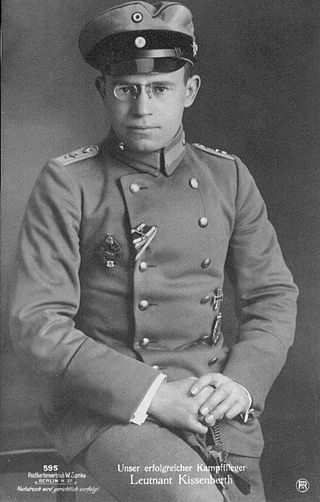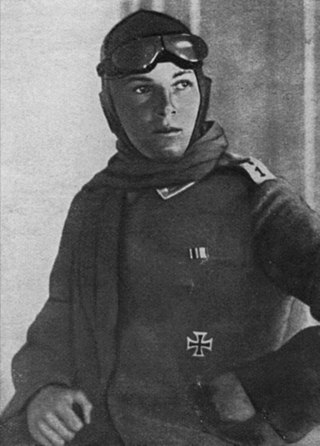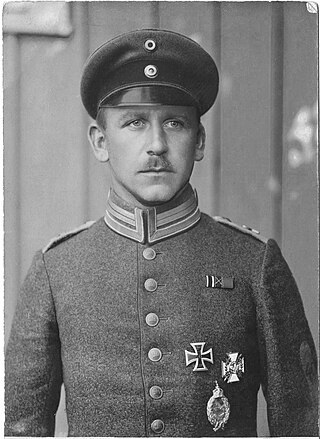Related Research Articles

Otto Kissenberth was a German flying ace of World War I credited with 20 aerial victories. He was a prewar mechanical engineer who joined the German air service in 1914. After being trained and after serving as a reconnaissance pilot, he became one of the first German fighter pilots, flying with Kampfeinsitzerkommando KEK Einsisheim. He scored six victories with this unit as it morphed into a fighter squadron, Jagdstaffel 16. His success brought him command of Jagdstaffel 23 on 4 August 1917. He would run his victory tally to 20, downing his final victim using a captured British Sopwith Camel on 20 May 1918. Nine days later, a crash while flying the Camel ended Kissenberth's combat career. His injuries were severe enough he was not returned to combat, instead being assigned to command Schleissheim's flying school. Although Otto Kissenberth survived the war, he died soon after in a mountaineering accident on 2 August 1919.
Leutnant Hermann Becker, was a World War I German flying ace credited with 23 victories.
Friedrich Altemeier was a German World War I flying ace credited with 21 confirmed aerial victories. Due to his distinguished faithful military service and piloting skills, he became one of the test pilots for Germany's last and best fighter airplane of the war, the Fokker D.VIII.

Karl Paul Schlegel was a German World War I flying ace credited with 22 victories. Schlegel was shot down by French ace Petar Marinovich. He was the last German ace to be killed in World War I.
Leutnant Fritz Gerhard Anders was a World War I flying ace credited with seven aerial victories. He was the world's first night fighter ace.
Leutnant Helmut Dilthey IC was a German pilot who became a World War I flying ace credited with seven aerial victories.
Leutnant Wolfgang Güttler was a World War I flying ace credited with eight aerial victories. He would score the first four while flying with Jagdstaffel 24, and the last four while flying as commander of Jagdstaffel 13. He was killed in a midair collision over his home airfield on 20 February 1918.
LeutnantWalter Böning was a German World War I flying ace from the Grand Duchy of Oldenburg credited with 17 aerial victories. He began his World War I military service as an infantryman. He distinguished himself by winning both the Gold Medal for Bravery and the Second Class Iron Cross. He then transferred to aviation duty, training originally as a reconnaissance pilot before advancing to become a fighter pilot. Between 6 April 1917 and 30 May 1918, he was credited with 17 aerial victories. On 31 May 1918, he survived a midair collision while being attacked by British fighters. Although he coaxed his damaged machine home, the serious leg wound he had suffered sidelined him through war's end.
LeutnantHans Böhning, Iron Cross, was a German World War flying ace credited with 17 aerial victories. He served the German Empire first as an artilleryman, then as an aerial observer for artillery, as a fighter pilot, and finally as the Staffelführer of a fighter squadron.
LeutnantKarl Odebrett was a German World War I flying ace credited with 16 aerial victories.

Offiziersstellvertreter Edmund Nathanael was a World War I flying ace credited with 15 aerial victories. He flew both two-seater reconnaissance aircraft and single-seater fighter craft. He scored all his victories while flying for Royal Prussian Jagdstaffel 5, and received a rare award of the House Order of Hohenzollern for his valor. He was killed in action while serving the German Empire.
Major Theodor Quandt was a World War I German flying ace credited with 15 aerial victories. He would return to his nation's service for World War II, being killed on 6 June 1940 during the Fall of France.
LeutnantPaul Strähle was a German World War I flying ace credited with 15 aerial victories.
Leutnant Johannes Max Janzen was a World War I flying ace credited with thirteen aerial victories. He returned to Germany's military service during World War II, and died in a Russian prison camp on 18 October 1945.
Leutnant Hans von Keudell was a World War I flying ace credited with twelve aerial victories.
Leutnant Franz Brandt was a German World War I flying ace credited with ten confirmed aerial victories, as well as three unconfirmed claims.

Royal Bavarian Jagdstaffel 16 was a "hunting group" of the Luftstreitkräfte, the air arm of the Imperial German Army during World War I.
Royal Bavarian Jagdstaffel 23 was a "hunting group" of the Luftstreitkräfte, the air arm of the Imperial German Army during World War I. As one of the original German fighter squadrons, the unit would score a minimum of 63 verified aerial victories. They scored twelve wins over enemy observation balloons as a squadron.
Leutnant Herbert Wilhelm Franz Knappe was a German flying ace during World War I. He was credited with nine confirmed aerial victories while fighting on both the Russian Front and Western Front.
HauptmannPaul Henning Aldabert Theodor von Osterroht IC was a German military aviation pioneer who became a flying ace in World War I. After valorous service as a bomber pilot and commander, he was called upon to found one of the original German Jagdstaffels. By March 1917 he led that unit into combat. Between 29 March and noon of 23 April, he scored seven aerial victories. Six hours later, he was killed in action while on patrol.
References
- Above the Lines: The Aces and Fighter Units of the German Air Service, Naval Air Service and Flanders Marine Corps, 1914–1918. Norman Franks, Frank W. Bailey, Russell Guest. Grub Street, 1993. ISBN 0-948817-73-9, ISBN 978-0-948817-73-1.
- Albatros Aces of World War I. Norman Franks. Osprey Publishing, 2000. ISBN 978-1-85532-960-7